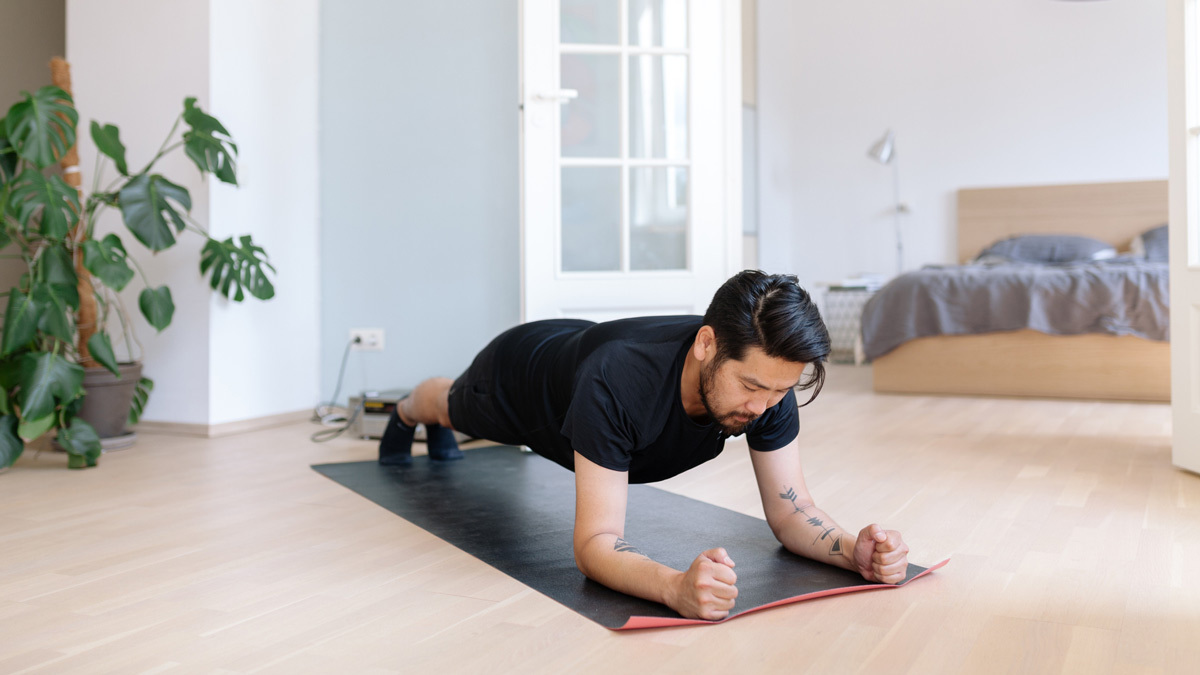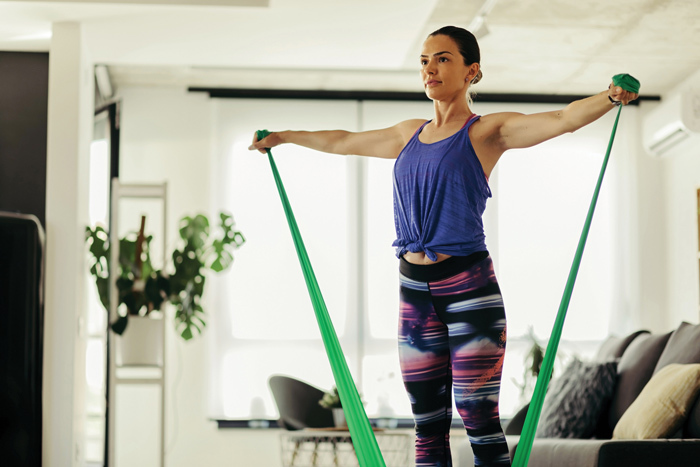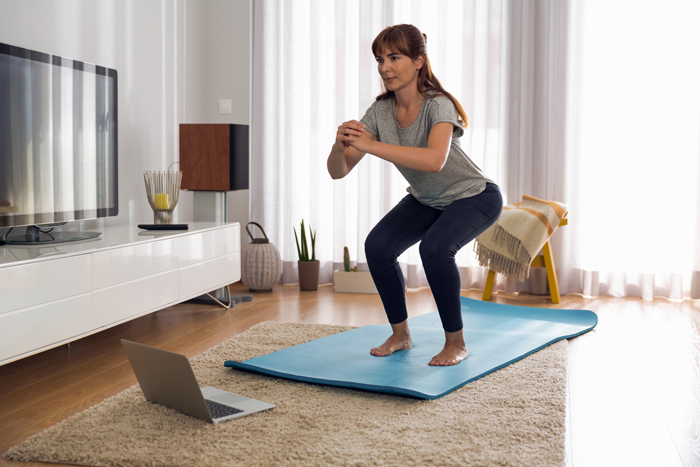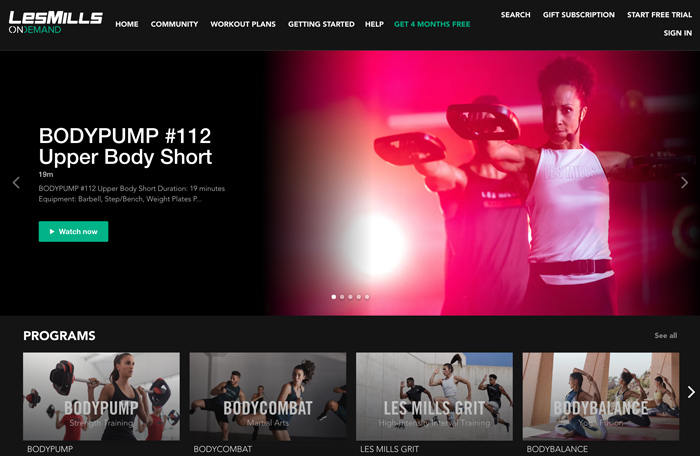Get our independent lab tests, expert reviews and honest advice.
How to create your own gym at home

Most of us are aware that we should get regular aerobic exercise, such as jogging, cycling or brisk walking. In fact, the government’s physical activity guidelines recommend that, every week, adults do at least 150 minutes (2.5 hours) of moderate aerobic activity, or 75 minutes (1.25 hours) of vigorous aerobic activity.
On this page:
- Resistance bands and tubes
- Free weights: barbell or dumbbells?
- Functional resistance training
- Make a home gym from your odds and ends
- What not to buy
- Home workouts
The importance of resistance training
What is perhaps less widely known is that resistance training (also called ‘strength training’) is essential to physical health, too. The government’s guidelines recommend that – on top of the recommended amount of aerobic exercise – adults do at least two resistance training sessions a week, and that each session last 20–30 minutes and work all major muscle groups.
Don’t want (or feel able) to join a gym? Well, the good news is that you don’t have to.
With a little shopping around, some creativity, and just $100, you can create your own home gym with resistance bands and/or free weights for your basic workout, and some optional extras for added benefit.

Resistance bands and tubes
Resistance tubes
These are heavy-duty elastic cords designed for strengthening muscles. They often come with padded handles and you can get them in single strands, multiple strands, figure 8s and loops. You can use one or more tubes at a time to alter resistance.
Resistance bands
These are a similar concept, but are flat, wide sheets of latex, often used for physiotherapy, yoga and Pilates.
Bands and tubes can cost as little as a few dollars each, while a kit with several tubes in a range of resistance levels, plus accessories such as door attachment, handles and ankle cuff, can be found for around $30.

Free weights: barbell or dumbbells?
A barbell is a long, weighted bar with ‘plates’ added, held with two hands. Dumbbells can be held in one hand.
Dumbbells are often recommended for beginners because:
- they let you focus on particular muscles, one side at a time, to develop good technique
- they offer a greater range of motion and more muscles are engaged to keep you balanced
- they’re extremely versatile and can exercise just about every muscle group.
On the other hand, barbells are much more convenient for exercises with heavy weights, such as squats and deadlifts.
If you’re a beginner
If you’re just beginning strength training, you could start with dumbbells (from $30 for a 20kg set) and buy a barbell (from $40, including weights) later.
Because you need different weights for different exercises, you’ll probably need to frequently swap the plates on the barbell. Look for “collars” – these are the locks that secure the weights to the barbell – that let you change plates easily.
Lever locks and spin-lock collars (where the collar screws on from the end of the bar) are good choices.
Are free weights for you?
Pros
- You can add plates to your set as you progress.
- They can be used to exercise all muscles.
- They’re relatively easy to store.
- They can be used on their own to increase difficulty of squats, sit-ups, etc.
Cons
- They can be dangerous – you’ll need to keep them out of reach of children.
- It’s easy to injure yourself with poor technique and heavy weights.

Functional resistance training
A more recent trend in strength training is a move away from exercising muscles in isolation to exercising lots of muscles simultaneously with practical actions and natural movements – so-called functional training.
Movements take place in three planes: front-to-back, side-to-side, and rotational; with the goal to develop strength, balance, flexibility and coordination, while training the brain as well.
For example, instead of building leg strength by lying down on a gym machine and pushing up weights with your feet, you do squats – as if you were sitting on and rising up from a chair.
As you get stronger, you can increase the challenge by holding weights.
This exercise not only builds strength but helps develop balance and coordination – important as we get older, and find sitting and rising more challenging.
Pros
- Value for money.
- If done properly, you’ll give yourself an excellent full-body workout that’s novel and fun.
- Provides practical skills and strength that are useful for everyday activities.
- Can be done solo or with other people.
- You can create equipment out of items you might have at home.
Cons
- Technique is everything – if you don’t get it right it could be useless, or worse, harmful. Seek advice from a qualified personal trainer before you start.
- Some homemade equipment can be pretty bulky, making storage and workout space an issue.
Make a home gym from your odds and ends
Gym closures due to the COVID-19 pandemic have sent people running to the shops for weightlifting gear, so you may have trouble buying equipment, especially if you’re not willing to pay inflated prices.
Empty bottles, a sledgehammer, an old truck tyre, bricks, sand, sacks and duffle bags, shovel and rope are some of the many everyday objects that can be used for a workout.
Top tips for making improvised gym equipment
- A 2 litre milk bottle filled with water is about 2kg. Filled with sand it’s about 3kg. Filled with pebbles it’s about 3 to 3.5kg (depending on the size of pebble). Filled with pebbles and water it’s about 4kg. They make good hand weights. Hang one or more on each end of a broomstick and you have a barbell.
- Whacking a truck tyre with a sledgehammer involves full-body movement, exercises just about every muscle, and can be a great stress-buster! Shovelling dirt, sand or gravel is another full-body rotational exercise.
- Home-made sandbags can be used for lifting and carrying.
- Shopping bags filled with large bottles of water, sandbags or bricks are perfect for the ‘farmer’s carry’, a traditional strongman event.
- Sled dragging is popular, where a smooth sled (or similar) is filled with something (or someone) heavy and pulled along grass.
- An old basketball or soccer ball filled with sand and sealed up becomes a medicine ball for throwing and catching – or simply held to create extra weight when doing crunches, squats and lunges.
- You could get a few friends together for tug-of-war and ‘wheelbarrow’ races (the ‘wheelbarrow’ walks on their hands while the operator holds their feet).
Although this equipment lacks the glamour of a shiny, expensive set of chrome and steel, it’s cheap, effective, novel and fun!
If you’re interested in this type of workout, your best bet is to find information on the internet and use care and common sense, or find a personal trainer who can guide you.
How to make a medicine ball
Cut a hole or V-shaped flap into a basketball or soccer ball
Using a funnel, fill the ball with sand (for a lighter ball you could use rice, styrofoam or salt)
You may need to shake the ball occasionally to make room for more sand
Weigh your medicine ball and add or remove sand until it reaches your desired weight
Seal the hole using a rubber patch repair kit or heavy duty tape
Consider sealing the entire ball with a layer of duct or athletic tape for extra security
Use your new medicine ball for throwing and catching, or as extra weight when doing crunches, squats and lunges
Credit: trackstarusa.com
What not to buy
Set-weight dumbbells
When starting out, you might be tempted to buy set-weight dumbbells weighing one or two kilos. However, you’ll outgrow lighter weights very quickly and will inevitably need to buy (more expensive) heavier ones.
Set-weight dumbbells have their place, particularly among serious weightlifters who like being able to change weights quickly. But for most people a set of adjustable dumbbells that you can add weight to is a better long-term investment.
Abdominal exercise devices
These can make sit-ups and crunches easier – but perhaps too easy. They’re bulky, useful only for one type of exercise, and you’ll probably outgrow them quickly.

Home workouts
So, you’ve got your home gym equipment – but what do you do with it? There are hundreds of apps and online video franchises for home-based workouts, and if you don’t have any equipment, you’re covered as well. Here are some suggestions to get you started.
Designed by a sports physician, the New York Times 9-Minute Strength Workout exercises your whole body – no equipment needed. There are nine exercises, which you do for one minute each, with detailed instructions and videos for each exercise. If it’s too easy or too hard, there are suggestions for making it more or less challenging, and as you improve you’ll extend the time for each exercise.
The same team also shows you How to Build Muscle in 9 Minutes, for which you’ll need hand weights (such as dumbbells). Again, there are nine exercises, done for one minute each, with suggestions for making it easier or harder.
There are hundreds of apps and online video franchises for home-based workouts
If you love variety, you’ll appreciate Fitness Blender‘s huge range of no frills video workouts which you can filter by time (from as little as 5 minutes to more than an hour), type of workout, difficulty level and equipment required. It’s free, though there are fitness and nutrition programs you can buy.
Also popular is the Popsugar Fitness YouTube channel, with a variety of free workouts, with and without equipment.
Gym members may already know about Les Mills classes, such as Body Pump (weightlifting), Body Attack (high energy fitness), RPM (indoor cycling) and Body Balance (yoga-inspired workouts). They’re also available at Les Mills On Demand, with a free trial period, after which it’s $24.99 per month. Check with your gym – it may have arranged a better deal for members during the COVID-19 closures. You’ll need equipment for some classes.
Apps are another option. Nike Training Club offers 190+ free classes, and by entering some data about yourself it will offer suggested workouts. Aaptiv provides thousands of audio-based workouts, so you don’t have to look at your phone. There are options for at home, running outside or at the gym ($US14.99 per month; free trial period).


